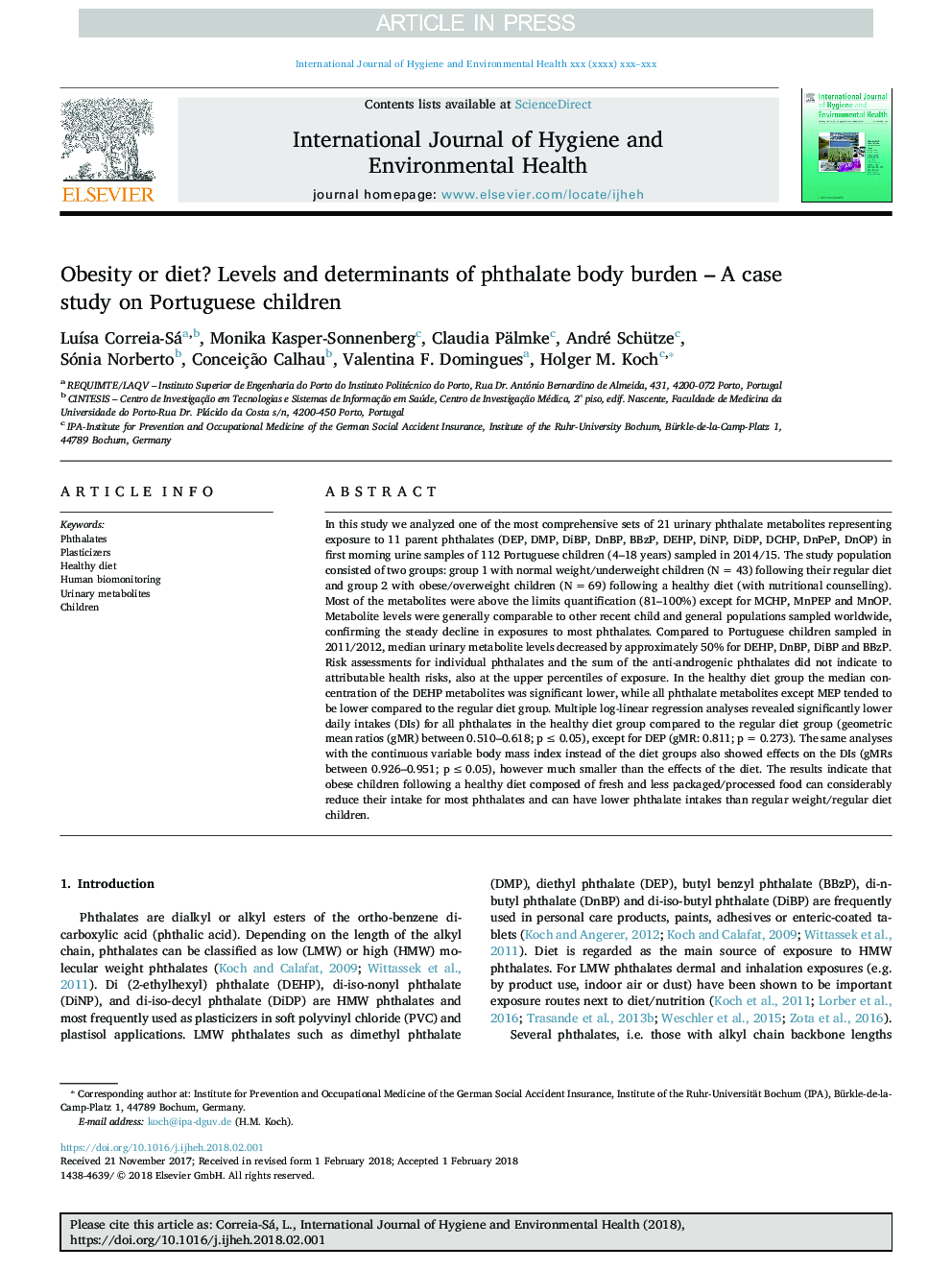| کد مقاله | کد نشریه | سال انتشار | مقاله انگلیسی | نسخه تمام متن |
|---|---|---|---|---|
| 8549718 | 1561866 | 2018 | 12 صفحه PDF | دانلود رایگان |
عنوان انگلیسی مقاله ISI
Obesity or diet? Levels and determinants of phthalate body burden - A case study on Portuguese children
ترجمه فارسی عنوان
چاقی یا رژیم غذایی؟ سطوح و عوامل تعیین کننده بار فونداسیون بدن - مطالعه موردی در مورد کودکان پرتغالی
دانلود مقاله + سفارش ترجمه
دانلود مقاله ISI انگلیسی
رایگان برای ایرانیان
کلمات کلیدی
فتالات پلاستیک رژیم سالم، بیومونیتوری انسانی، متابولیت های ادرار، فرزندان،
موضوعات مرتبط
علوم زیستی و بیوفناوری
علوم محیط زیست
بهداشت، سم شناسی و جهش زایی
چکیده انگلیسی
In this study we analyzed one of the most comprehensive sets of 21 urinary phthalate metabolites representing exposure to 11 parent phthalates (DEP, DMP, DiBP, DnBP, BBzP, DEHP, DiNP, DiDP, DCHP, DnPeP, DnOP) in first morning urine samples of 112 Portuguese children (4-18 years) sampled in 2014/15. The study population consisted of two groups: group 1 with normal weight/underweight children (Nâ¯=â¯43) following their regular diet and group 2 with obese/overweight children (Nâ¯=â¯69) following a healthy diet (with nutritional counselling). Most of the metabolites were above the limits quantification (81-100%) except for MCHP, MnPEP and MnOP. Metabolite levels were generally comparable to other recent child and general populations sampled worldwide, confirming the steady decline in exposures to most phthalates. Compared to Portuguese children sampled in 2011/2012, median urinary metabolite levels decreased by approximately 50% for DEHP, DnBP, DiBP and BBzP. Risk assessments for individual phthalates and the sum of the anti-androgenic phthalates did not indicate to attributable health risks, also at the upper percentiles of exposure. In the healthy diet group the median concentration of the DEHP metabolites was significant lower, while all phthalate metabolites except MEP tended to be lower compared to the regular diet group. Multiple log-linear regression analyses revealed significantly lower daily intakes (DIs) for all phthalates in the healthy diet group compared to the regular diet group (geometric mean ratios (gMR) between 0.510-0.618; pâ¯â¤â¯0.05), except for DEP (gMR: 0.811; pâ¯=â¯0.273). The same analyses with the continuous variable body mass index instead of the diet groups also showed effects on the DIs (gMRs between 0.926-0.951; pâ¯â¤â¯0.05), however much smaller than the effects of the diet. The results indicate that obese children following a healthy diet composed of fresh and less packaged/processed food can considerably reduce their intake for most phthalates and can have lower phthalate intakes than regular weight/regular diet children.
ناشر
Database: Elsevier - ScienceDirect (ساینس دایرکت)
Journal: International Journal of Hygiene and Environmental Health - Volume 221, Issue 3, April 2018, Pages 519-530
Journal: International Journal of Hygiene and Environmental Health - Volume 221, Issue 3, April 2018, Pages 519-530
نویسندگان
LuÃsa Correia-Sá, Monika Kasper-Sonnenberg, Claudia Pälmke, André Schütze, Sónia Norberto, Conceição Calhau, Valentina F. Domingues, Holger M. Koch,
